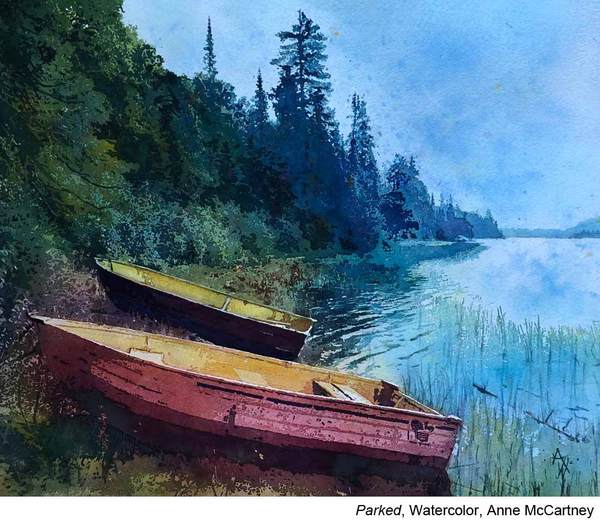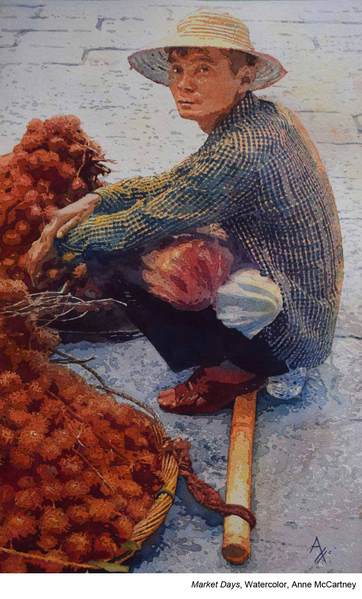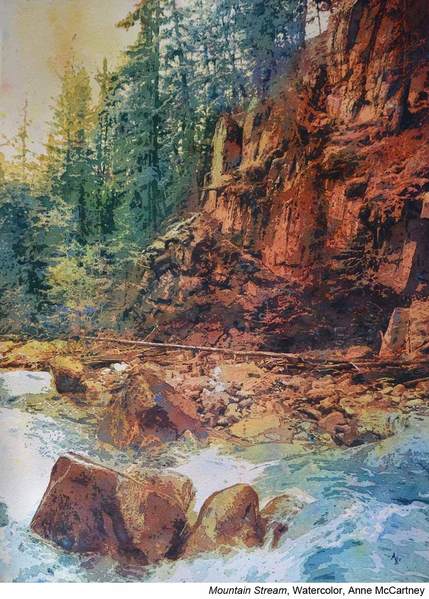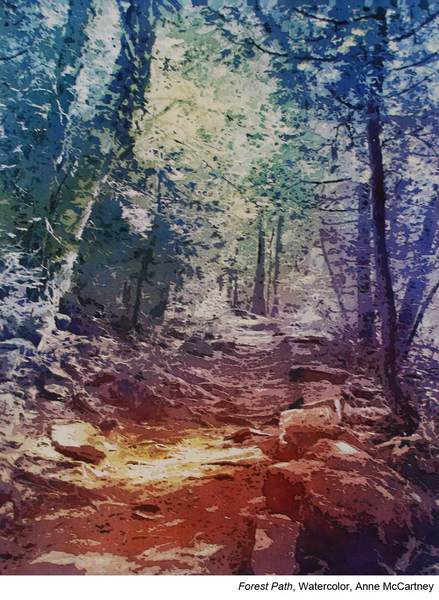
“I do almost all of my planning on my computer before I start to paint,” says watercolor artist Anne McCartney. “I might remove elements from a reference photo, change the horizon line, adjust the lighting, or any number of other things, just to make the image interesting enough to paint. I need to make sure there are areas that will engage the viewer, and if there is too much detail, that it’s removed.
“This might take hours of sitting at the computer deciding on compositional elements such as contrasts, focal areas, cropping.”

Telling a Story With Watercolor
“I usually look for some kind of narrative in an image,” she says. “If the image can take me somewhere or make me wonder, I hope that, if painted, it would do the same for the viewer. That might mean that the image needs an element in it that makes a strong focal point, or an area that holds particular interest as a focal area. Or maybe the light is just right and highlights something interesting.
“I will sometimes start off looking at my huge reference library of photos and think I know the exact image I am looking for, only to get distracted by another, which is the one I end up painting. Maybe if I can get distracted by it, others will as well.

Cropping Reference Photos for Maximum Effect
“Cropping a photo is an important tool to making sure the image I am about to paint is all that it can be and not more than it needs to be. I consider what is needed to tell the narrative and also what the format needs to be, then I crop accordingly.
“My primary question when I start to crop is ‘what do I find interesting about this photo?’ If it is a landscape, do I want to include the sweeping expanse or to zoom in on an aspect of it? Would a panoramic format suit better than a standard 1:2 ratio? If it’s a figurative piece, how much of the surrounding area is necessary to convey the story? I really don’t want or need to paint elements that are not necessary, so getting rid of them by cropping seems logical.”

Watercolor Painting Process
“My process is a long one with many repeat stages,” says the artist. “In total, I spend between 150 to 200 hours working on one of my paintings.
“Once I have an image that is ready to paint, I do an underpainting. I like to tone my paper, as it makes it less intimidating than a white sheet of paper. The underpainting is really just to give texture and underlying unity to the piece. With the underpainting, I usually create a sort of bullseye with a yellow in the focal area, next a red, and then blues at the outside.

“After the initial wash, I start my process of drawing, masking, and then painting. This is repeated until all the values have been met. I work light to dark as most watercolorists do, building my values with each layer. I usually leave an hour before painting over masking and 24 hours to mask over paint.
“Once all the layers are created, usually ranging from 6 to 12, I remove all the masking and hope that all the values are accurate, so that the painting has depth and coherent details. If the masking has lifted any pigment, I will need to do touch-ups.”

Staying Focused
“I have a few tricks that serve as reminders to help me keep on track with where I am on a piece. I use an 8 1/2 x 11-inch black-and-white printed copy of the image I am working on and I keep this close to the painting. I’ll use this print-out to write notes on. When I have finished a layer, I mark on the printed version which value I will start next. I also note things like paint choices for this particular painting (hue and brand), or what I had decided on as a focal area.
“Most of the time it’s not hard to keep in mind where I am with a piece but I do find that jotting down a reminder on a sticky note and attaching it to the painting has also been very helpful in the past.”
Essentially self taught, watercolor artist Anne McCartney began seriously painting in 2005. Encouraged by the Alberta art community, where she calls home, she has since created a substantial body of work and exhibited in many shows. Her love of the landscape and her constant travels have been a source of never-ending inspiration for her work.








Wonderful article. I also follow same methodology.when i see something interesting
I dream about it,sleep over it ,then sketch it,date it,decide colour palette and then commence the final work.These days my emphasis is on quality rather than quantity.
Thank you Anne! Our processes are very similar, although I now mask 2-3 layers and then move to brushwork. I always enjoy seeing your fascinating paintings.
I don’t like this kind of approach, let me explain: I don’t see the “creativity wave”, If someone make some Photoshop on a picture and then paint I ask myself if there’s some technique and skills in achiveing some sort of effect and light, or is just a mere copy of a Photoshopped picture? I saw it too “mechanical” it seems to me like forcing the painting and build the scene artificially, except for cropping, that is essential for some pictures.
Anyway is a way to do things, so if she is happy with her way, it’s right continue on that path!
Very interesting article. I am anxious to know which computerprogram she uses for cropping, removing, adjusting ect
Can you please tell us what software you prefer to use in your planning stage? Thanks!
I agree…too much work!! But it does work for you and I love the paintings here! My process is to take a bunch of pictures or photos of what I want to paint, then take a little from this one and a little from that. (Same way I cook 😊). Then I try to draw/sketch it. I then do 1 or 2,3, “practice paintings.”. Since you are famous and I am not, yours is best!